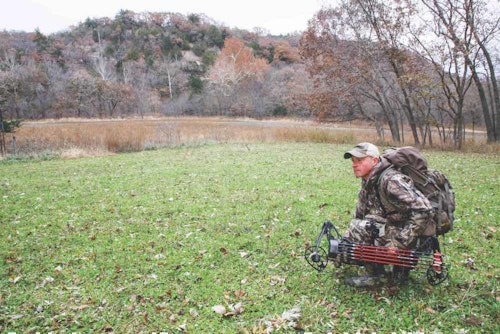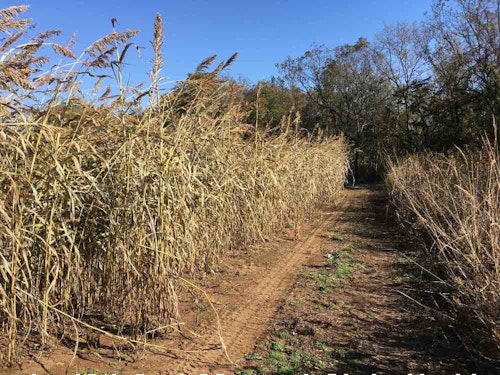
With a solid game plan you can take an average property and turn it into a whitetail paradise. The key is offering a balance of top-notch food and cover, then limiting hunting pressure so deer feel safe. (Photo by Dave Maas)
The business of whitetail property management is booming. One article I researched from the Quality Deer Management Association (now called the National Deer Association) archives highlighted that back in 2013, there had already been a 2,400 percent increase over the previous five years on food plot product sales! Can you imagine what it is today as you drive across the country and see all the food plots tucked behind timber stands?
With this explosion of land management focused on food for whitetails, you do have to ask yourself. “Is there such a thing as too much Eden? What’s the right balance of food and cover, especially when only a limited amount of property is available for management?”
Too Little Food?
Few whitetail property managers complain about having too much food on hand for the local whitetail herd. The opposite is generally true and more than obvious at the end of winter when food sources have been ravaged, or the majority of the herd has left for greener pastures weeks earlier.
An obvious browse line on trees, shrubs and other vegetation — 4 feet and less — indicates the deer are utilizing every leaf and woody browse they can reach. It also indicates that you lack quality food, both native and agricultural. When this occurs, deer must move to find the nutrition they need.
Even when whitetail fanatics add food to a property, the efforts could still lead to bare cupboards. A major consideration is the locale’s weather. Poor timing, unexpected drought, hail or even too much moisture can affect the productivity of a food plot. Whitetail managers often make the mistake of planting the wrong seed, too. Soybeans are the perfect example. The food plot looks promising initially, but when the vegetation reaches a peak for taste, the deer over-browse, especially in fields less than 2 acres in size. The high palatability and attractiveness of young soybeans in small fields cannot sustain the browse pressure and often fail to grow.

Too Much Food?
You may think you can never have too much food, but there should be a happy medium to ensure deer have adequate nutrition year-round and to pattern them during hunting season.
Consider a property loaded with oaks. These wonderlands of nut production can be difficult at best to hunt, particularly during early season. Deer can visit a hardwood forest and utilize acorns anywhere, thus ignoring a regular pattern. The same is true of a property with scattered food plots. If you sporadically place food plots throughout the property with many of the same crops, it can be more difficult to pattern how the deer will utilize these food sources.
So what is the right amount of food plots? There’s no easy answer; you (or a hired pro) must evaluate the native composition on the property, existing farm practices, neighboring farm practices, deer density and regional location. That said, the following breakdown should get you started on the right path.
For agricultural zones where crops are plentiful, most experts recommend having 5 to 10 percent of the land in a food source. If the property is located in a hardwood region, forested or in open pasture ground, the recommendation jumps to 10 to 15 percent of the property in food.

Not Enough Sanctuary?
Although food gets the spotlight in terms of whitetail property management, a sanctuary could be a more vital component to whitetails embracing home ownership on your land. Without sanctuary or refuge habitat, all the food in the world can’t give deer peace of mind. Don’t be MIA when it comes to habitat cover.
Remember that by tackling wildlife cover, you also increase the amount of native browse available. By improving cover, it can also provide additional food sources within sanctuaries.
Think about it this way: You can have the best food plots in the state, however, if you cannot provide quality cover for your deer, they will most likely bed elsewhere and utilize your magnificent plots only during the cover of nightfall.
It’s important to understand that improving sanctuary habitat is a long-term investment. Moreover, planting cover such as Egyptian wheat or sorghum can act as a buffer as forestry projects mature.

Too Much Sanctuary?
Is it possible to have too much escape cover or refuge on a property? In general the answer is likely “no.” Finding a happy medium of food and cover is always a balancing act. Even though food attracts whitetails to a property, cover holds them, so the more, the better.
Sanctuaries and high-quality cover should always be the first focus of any whitetail manager. Without top-notch cover and ample bedding locations, it is almost impossible to attract and hold deer on your parcel.
Almost all wildlife property specialists recommend creating zones where all human intrusion is off limits. Percentages vary, but the idea of a sanctuary is to make deer feel comfortable and at home. That’s hard to do if you continually invade their space.
Many experts recommend setting up sanctuaries in two locations on a property if the habitat allows. It’s commonsense — deer can move to and from each sanctuary location without the fear of pressure. It also provides deer multiple locations to visit food depending on when the crops could be at the peak of palatability.
Another benefit to having two sanctuaries is it opens up more opportunities for stand locations. Varying winds accompanied by incoming weather fronts cause you to abandon one stand for another to ensure scent invisibility. If you overhunt the edge of one sanctuary, your enthusiasm could give you away with weather changes.
When shopping for whitetail property, it’s key to focus on cover. The good news is cover is often maximized on a property that was neglected over a long period. More good news: Not only can these properties be purchased at a lower value because of their rough nature, the thick and overgrown character already has ample cover in place. With some trimming and clearing, food is added easier and faster than waiting 10 to 20 years for refuge cover to grow.
Sidebar: Find a Whitetail Dream Property
Finding the ideal hunting property has become easier in recent years. You can reach out to real estate specialists who concentrate strictly on marketing wildlife-rich properties and then consult with a land management professional to formulate a habitat-winning plan.
Look for the following elements in any wildlife property to optimize it to its true potential.
- At least 180 acres or larger (varying topography throughout is a bonus).
- Interspersed habitat including meadows, forested woodlots, brushy areas and croplands.
- Old or fallow field habitat.
- The addition of larger nutrition food plots and smaller hunting plots.
- Sufficient water in creek drainages and also several small watering holes.
- Sanctuaries set up in at least two locations.
- Road access to move equipment throughout the property.





